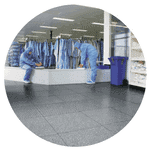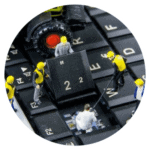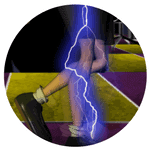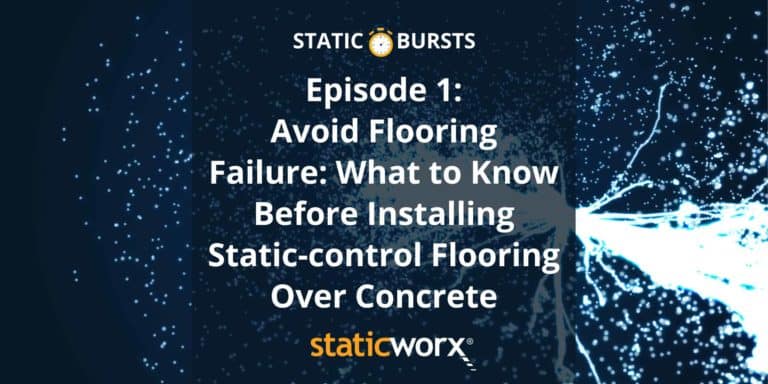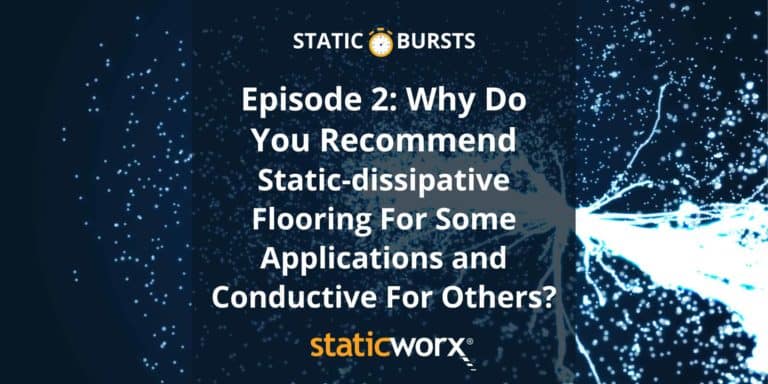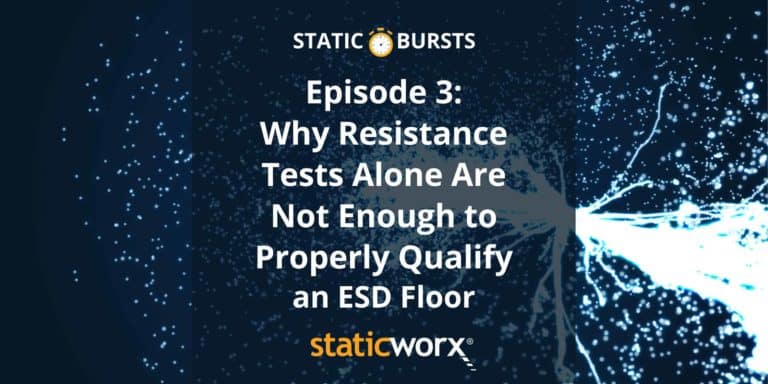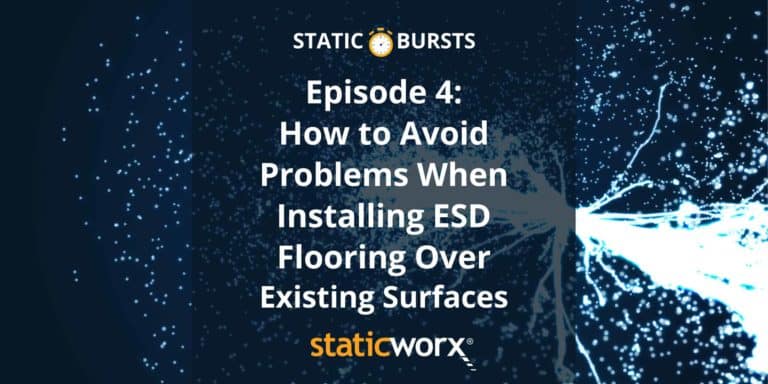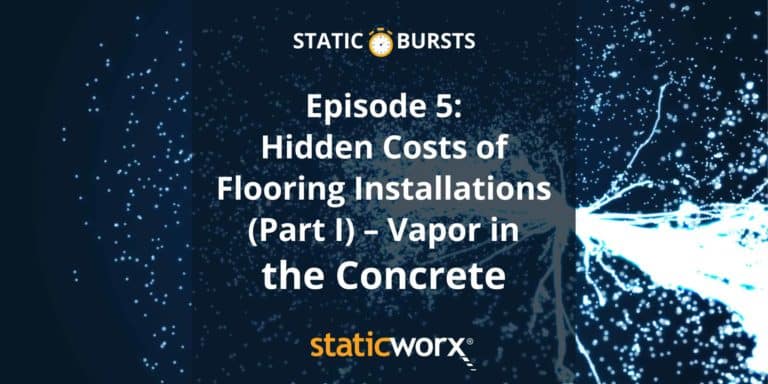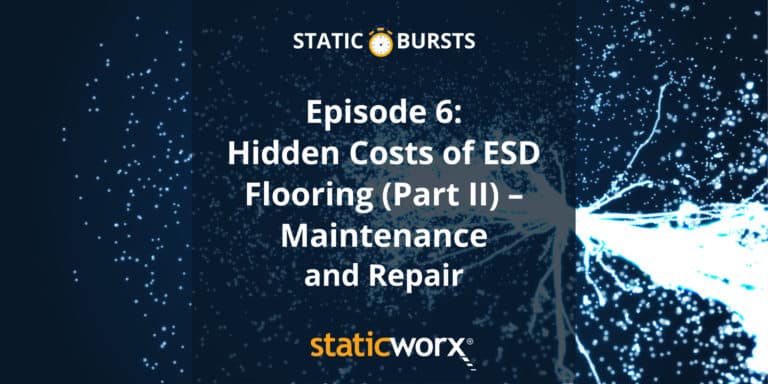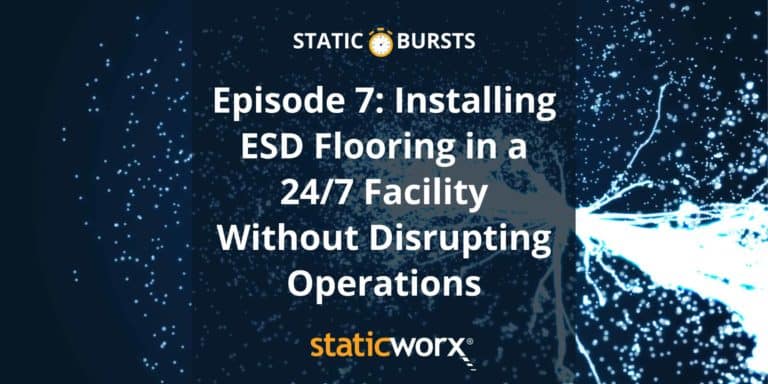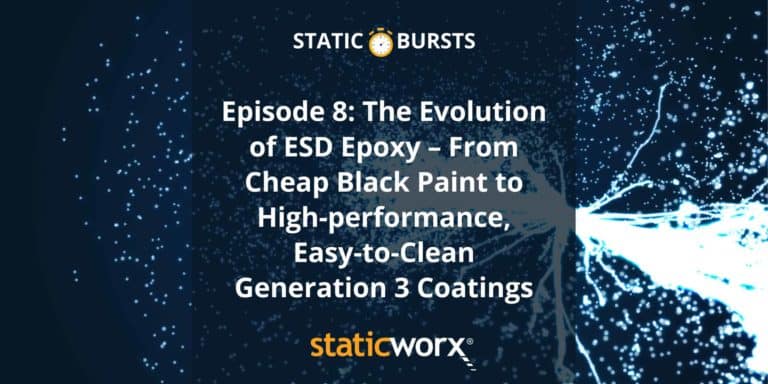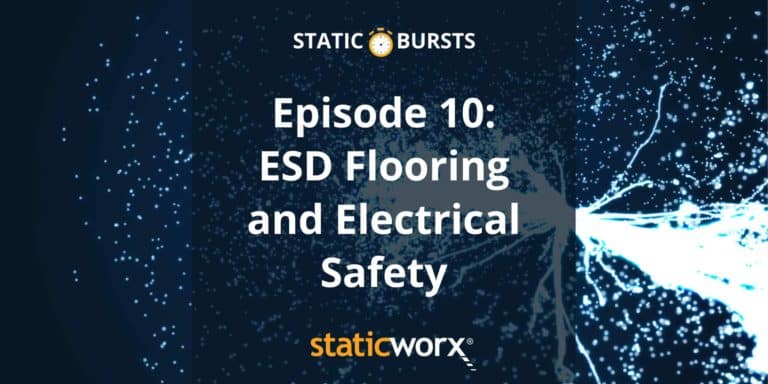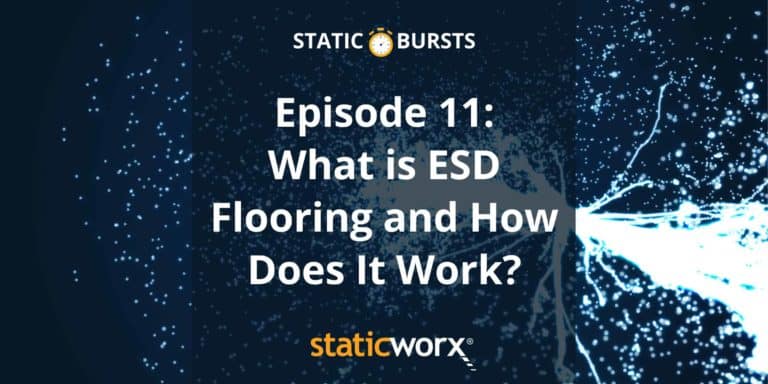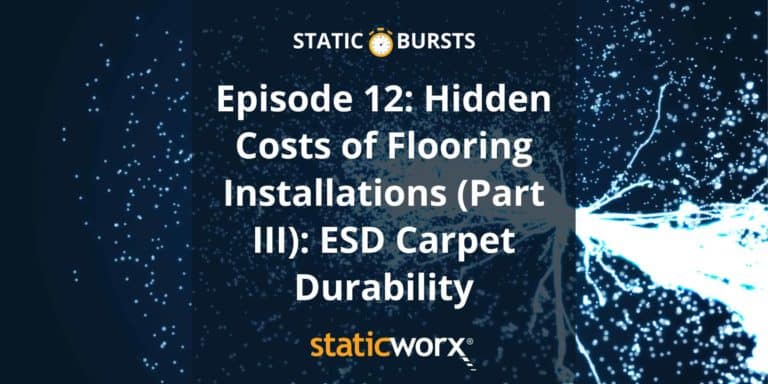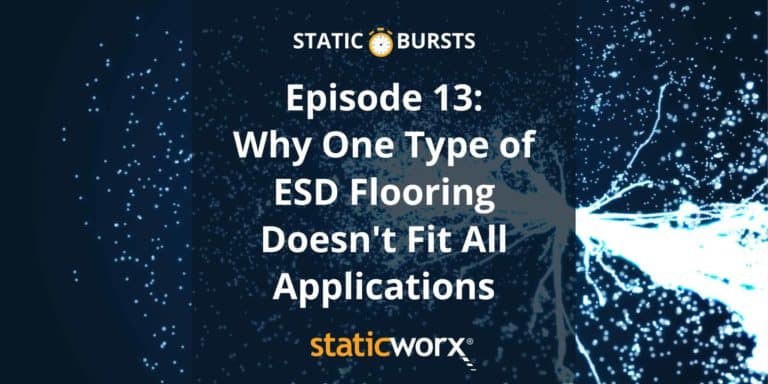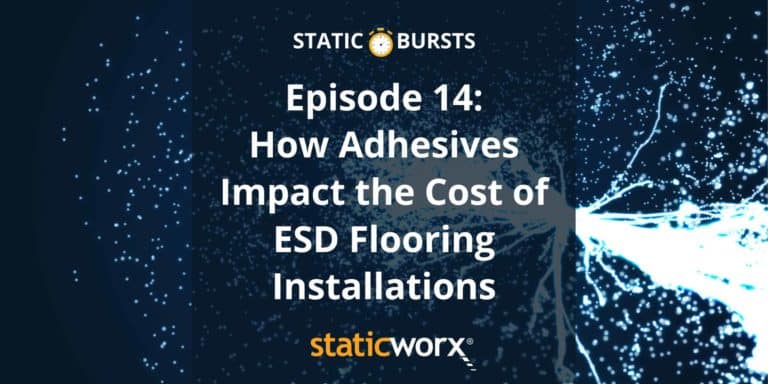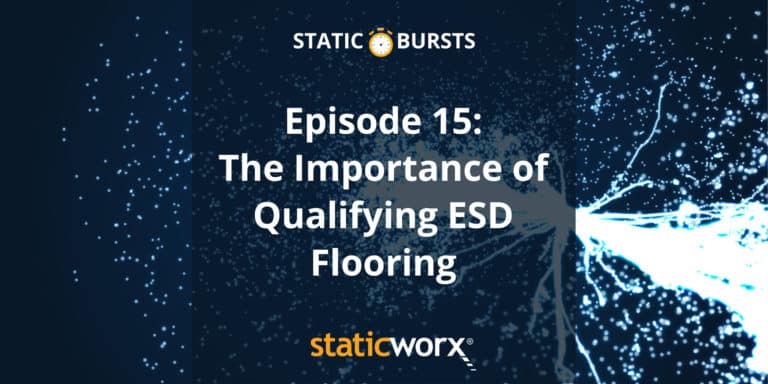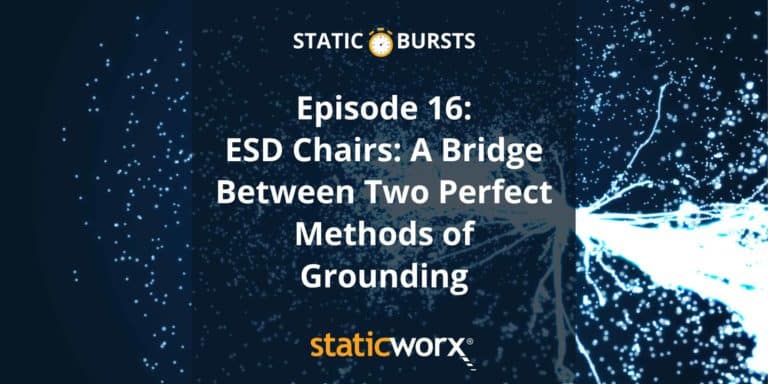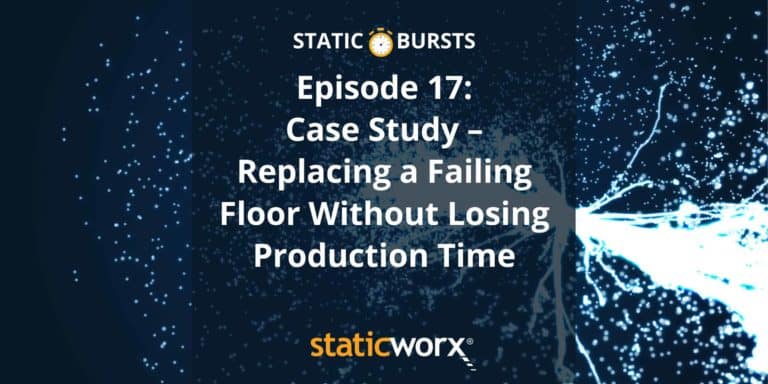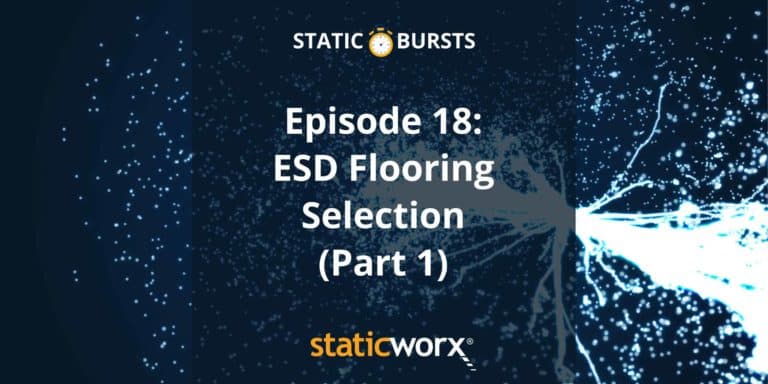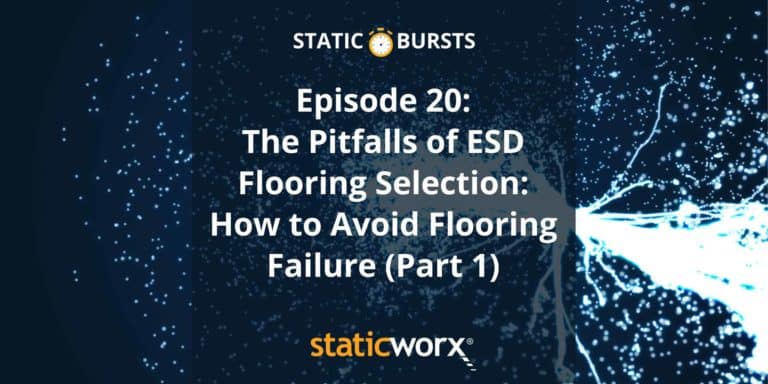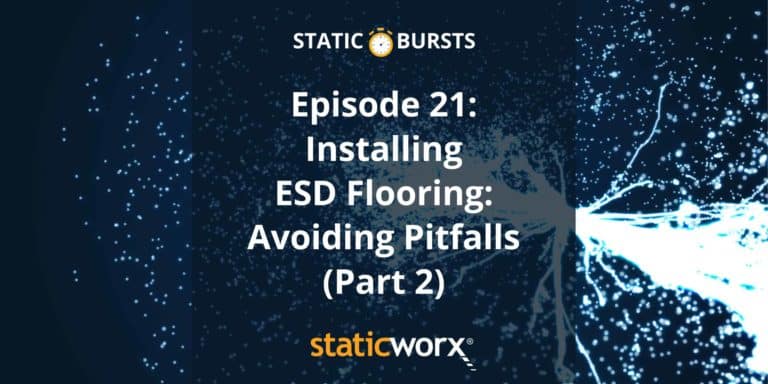Moisture problems are the #1 cause of failed flooring installations. Often the result of aquifers or other environmental conditions, moisture may be invisible. So how do you know if you have a moisture problem? How do you fix the problem? What happens if you choose to ignore moisture readings? If you’re in a 24/7 operational facility, such as a call or data center, a police station, a flight tower or other critical space, how do you solve a moisture problem – adhesive breakdown, for example – without shutting down or compromising your core mission? Dave Long, president of Staticworx, Inc., discusses these and other issues related to mitigating moisture in new construction, renovations, and occupied workspaces.

Static Bursts #19: ESD Flooring Selection (Part 2)
When choosing an ESD floor, it’s important to consider all the variables related to your specific application. Will you roll heavy loads on the floor? Do you need noise attenuation, anti-fatigue characteristics, or reflectivity? How long do you plan to stay in the building? When evaluating options, remember that the cost per square foot is only one part of the total cost of owning the floor. Installation, labor, maintenance, operational downtime add up – in the short term as well as over time.
The Gist: How to Choose a Static-Control Floor (Part 2)
Continuing from Part 1, when choosing an ESD floor, you need to consider key factors
- Will you roll heavy loads over the floor?
- Some floors appear hard but are actually soft.
- On a soft floor, rolling a heavy system could require 2 people rather than 1
- Noise attenuation
- In a call or dispatch center, where people need to hear conversations, noise can be a problem
- Soft surfaces like carpet and rubber are quieter than vinyl or epoxy
- In a call or dispatch center, where people need to hear conversations, noise can be a problem
- Anti-fatigue characteristics
- When people are standing/moving all day their feet (and back) get tired
- Softer surfaces are preferable for these areas
- When people are standing/moving all day their feet (and back) get tired
- Reflectivity/lighting
- If people are analyzing parts under magnification, will current lighting be sufficient with a particular floor? Or will you need to purchase new lighting?
- Cost vs Time in Building
- If you’ll be in the building long-term, you might want to invest more
- For a short-term occupancy, you might prefer a floor like Interlocking tiles or carpet tiles installed with TacTiles (rather than adhesive), as these floors can be lifted, moved and redeployed in a new space
- Cost – includes a number of factors
- Installation, labor, maintenance, operational downtime can add up
- Rather than considering only the cost per square foot, consider total cost of ownership
- Before deciding on a floor, put a matrix together and weigh all the factors
“…put a matrix together and weigh all [the] factors. Give them a score from one to five… What are the shutdown costs? Are there actually productivity costs I’m not taking into consideration? Consider installation strategies, maintenance, rolling loads, ergonomics… if you do this objectively…you’ll end up with, if not one choice, an intelligent opportunity to choose between one choice and another.”
We’ve made it easy to subscribe on your favorite platform!
Rick: Welcome to Static Bursts. Our podcast series will discuss the threat static electricity poses to your business and how to address those risks.
Dave: I’m your host, Dave Long, founder and president of StaticWorx. We make static-control flooring.
Rick: And I’m your co-host, Rick Frauton. And in this episode of static bursts we continue our discussion of the key factors to consider when selecting static-control flooring for your business. Previously, we discussed how application and aesthetics as well as installation and maintenance methods can influence your selection. Today we will be covering factors such as ergonomics, sound attenuation, and the total cost of ownership over time.
Dave, what else should buyers of ESD flooring consider when deciding which type of floor is most suitable for their facility?
Dave: Rolling loads. Suppose you’re in a data center or you’re in a factory where you’re building systems that are kind of heavy and they’re on four swivel-casters. Well, there are floors that look like they’re hard floors – like some of these invisible, like seamless, interlocking floors – they’re actually kind of soft. If you try to roll a heavy machine on them, the machine actually takes a set in the floor, and it’s a lot harder to move. If you’ve got employees that were accustomed, on bare concrete, to rolling a 3000 pound system without any problem just by pushing it with their hand – and suddenly you’ve given them an ESD floor that has a little bit of softness to it, that could be a problem that has nothing to do with all the other key parameters except that now you can need two people to move the system instead of one.
Another factor noise attenuation. Back to the call center. If it’s a police department say they have 10 dispatchers all involved in conversations in a large municipal area, and one of the important factors in those kinds of conversations is they need to concentrate on who they’re talking to. They need to be completely at ease and ready to help whoever calls. If those 10 conversations all jumble because the floor is a hard surface, and there’s a lot of noise in the room, that’s going to make their job a lot more difficult. So they may want to use a carpet solution, maybe a rubber solution. Carpet tends to attenuate noise, the best. Rubber, it’s okay.
It’s not vinyl, obviously, because vinyl would be a loud floor. It’s not an epoxy floor, which would be the probably the worst case scenario for them.
Anti-fatigue characteristics. If people are doing a job in a factory, where they don’t sit at work benches, but all day long, they’re moving systems and sliding circuit boards into the systems, their feet get tired. You don’t want to put them on an epoxy floor; that’s just going to make their job more difficult. They’re going to feel the pains of walking on a hard surface all day long.
So you may want to consider rubber or carpet where anti fatigue properties are needed.
Reflectivity. This was one that was brought to my attention recently, because in certain operations, there are, I guess you could say sub operations where people need to analyze parts under magnification. If the room is too bright, that could be a problem. If the room is too dark, it could be a problem. So you need to think about what kind of lighting do I have? Do I need new lighting to make it work with my floor?
And then I guess one of the real key factors is cost and time that you plan to be in the same space. And I’m rolling those together because, if you are going to sign a 10-year lease or buy a building, you can invest in that building. You can know that what you’re going to be putting in that building, you’re going to get the most out of it. But what if it’s a two year lease – you might want to think about an interlocking floor. You might want to think about one of these carpet tile solutions, like we offer that has what we call TacTiles that holds corners of carpet tiles together, securely, permanently – but if you decide to move, you can just peel them apart and redeploy them in the new space. Or the interlocking floor that Looks like a bunch of puzzle fingers that are all secured together. But when it’s time to vacate the space and move the floor, you can take it apart and bring it with you.
Rick: Well, that is certainly a lot to consider. And it’s clear why there isn’t one type of flooring that’s suitable for any given industry. One factor we have not discussed, which is surely on our listeners’ minds, is what is the cost of static-control flooring?
Dave: So I’ve left cost to the end. The only reason I have is I think all these other factors have something to do with cost. When people call us, the first thing they always want to know is what does an ESD floor cost? And I always tell them right up front, anywhere from x to z, and I give them some numbers based on the little bit of input that they usually give me when they ask that question. But the real heart of the matter is, if you haven’t thought about these factors that we just talked about, how are you going to analyze cost?
Suppose you buy a floor that’s on liquidation. It’s some company that brings in flooring from a foreign factory, and they’ve got an overage on it, and they decide to sell it to you for $2 a square foot. But the floor needs to be installed with an epoxy adhesive, and you’re going to be putting it in a clean room. You’re going to pay more money for the labor, because of the way it has to be installed and the prep work that has to be done, then that floor is worth. So you need to look at all the factors before you actually say, this is what it costs. I mean, there’s a lot of ways to put this but I guess the best way is total cost of ownership. Am I my willing to pay for something a little bit upfront, so that I don’t have to deal with a lot of other problems?
I’ll give you an example. There are vinyl products on the market, static-dissipative vinyl in particular, that require three to five coats of a special floor polish. If you’re an architect or a designer, and you specify that product, a lot of times you don’t even know about this wax, because it’s in the maintenance instructions. It’s not on the cut sheet about the product itself.
So what you’re actually telling the customer is, you’re going to buy this floor that typically sells for, I don’t know, I’m going to just use an average number that I hear. It’s going to cost $5 a square foot for the material, but then it’s going to turn around and cost you another $2 a square foot in maintenance every year. Well, that might get hidden because you’ve got two different budgets that are being drawn from but it’s same bank account.
So you need to really look at all the other factors before you put a number on cost. Same thing with carpet tile, you could have two different carpet tiles. If one of the carpet tiles is made with yarn that has an extremely low modification ratio – and by that I mean that the fibers are designed geometrically for durability and to prevent trampling, which in turn, diminishes the loss of appearance – if that carpet tile is the same price or even if it’s marginally more money, if it has a low modification ratio, it’s going to last a lot longer than an alternative product.
If you’re in a 9-1-1 call center, and you’re installing carpet tile as your static fix for your floor, your real cost isn’t the carpet tile. It’s figuring out all the strategies that you need to implement in order to put that new floor into that call center without shutting it down. So you might buy carpet tile, and I don’t know what the installer is going to charge you, but I’ll use a high number here. Call it $6 a square foot. If you’re paying $6 a square foot, but it’s going to cost you a tremendous amount of money and time to move consoles and have those consoles recertified by Department of Homeland Security because maybe you’ve disconnected your systems and they need to come in and make sure that you’re secure in your communications, the cost, real cost, might be in all the auxiliary things you need to implement in order to put that floor in.
You need to be looking at the floor and saying, I need to buy a design and a material that’s extremely durable, because I don’t want to do it again. So you might find something that’s half the cost. Maybe it’s once again on liquidation. What good is that going to do you if it’s something you’re going to want to replace in three or four years? So cost is not a number. Cost is an observation of a number of factors.
Rick: We now know that cost is not limited to the price per square foot for the flooring material alone. To understand the full cost of ownership over time, it’s very important to weigh factors such as installation methods and maintenance routines, as well as the cost of any operational downtime associated with these activities.
Dave, do you have any final thoughts for anyone who is responsible for selecting an ESD? floor?
Dave: So my advice in most cases, especially when I’m invited to decision meeting, is to put a matrix together and weigh all these factors. Give them a score from one to five, and maybe even factor in how they would influence your thoughts about cost. What are the shutdown costs? Are there actually productivity costs that I’m not taking into consideration? And do the math.
Put the numbers down, based on installation strategies, maintenance, rolling loads, ergonomics, whether it addresses your application or not. And I think if you do this objectively, and you do it fairly, and you include the right people in your organization, which includes people who work in the space, people are going to pay for the floor, people who are going to take care of the floor, I think what you’ll discover is you’ll end up with, if not one choice, an intelligent opportunity to choose between one choice and another. Because keep in mind, you’ve got carpet, you’ve got epoxy, you’ve got vinyl, you’ve got rubber, you’ve got sheet versions, rolls, of some of these floors. You’ve got waxes, you’ve got paints, the options are there. It’s a matter of intelligently and objectively choosing them and not having a closed mind to them. So the takeaway of this podcast is that you have to look at all the factors. If you don’t look at all the factors, you’ve got blinders on.
We hope you learned something today. If you have questions about the podcast, give us a call at 617-923-2000. Even though we specialize in solving problems with flooring, if you have a question about static discharge, how to install a floor, how to test the floor, we’ll be glad to help you. Thanks for listening.
Rick: Welcome to Static Bursts. Our podcast series will discuss the threat static electricity poses to your business and how to address those risks.
Dave: I’m your host, Dave Long, founder and president of StaticWorx. We make static-control flooring.
Rick: And I’m your co-host, Rick Frauton. And in this episode of static bursts we continue our discussion of the key factors to consider when selecting static-control flooring for your business. Previously, we discussed how application and aesthetics as well as installation and maintenance methods can influence your selection. Today we will be covering factors such as ergonomics, sound attenuation, and the total cost of ownership over time.
Dave, what else should buyers of ESD flooring consider when deciding which type of floor is most suitable for their facility?
Dave: Rolling loads. Suppose you’re in a data center or you’re in a factory where you’re building systems that are kind of heavy and they’re on four swivel-casters. Well, there are floors that look like they’re hard floors – like some of these invisible, like seamless, interlocking floors – they’re actually kind of soft. If you try to roll a heavy machine on them, the machine actually takes a set in the floor, and it’s a lot harder to move. If you’ve got employees that were accustomed, on bare concrete, to rolling a 3000 pound system without any problem just by pushing it with their hand – and suddenly you’ve given them an ESD floor that has a little bit of softness to it, that could be a problem that has nothing to do with all the other key parameters except that now you can need two people to move the system instead of one.
Another factor noise attenuation. Back to the call center. If it’s a police department say they have 10 dispatchers all involved in conversations in a large municipal area, and one of the important factors in those kinds of conversations is they need to concentrate on who they’re talking to. They need to be completely at ease and ready to help whoever calls. If those 10 conversations all jumble because the floor is a hard surface, and there’s a lot of noise in the room, that’s going to make their job a lot more difficult. So they may want to use a carpet solution, maybe a rubber solution. Carpet tends to attenuate noise, the best. Rubber, it’s okay.
It’s not vinyl, obviously, because vinyl would be a loud floor. It’s not an epoxy floor, which would be the probably the worst case scenario for them.
Anti-fatigue characteristics. If people are doing a job in a factory, where they don’t sit at work benches, but all day long, they’re moving systems and sliding circuit boards into the systems, their feet get tired. You don’t want to put them on an epoxy floor; that’s just going to make their job more difficult. They’re going to feel the pains of walking on a hard surface all day long.
So you may want to consider rubber or carpet where anti fatigue properties are needed.
Reflectivity. This was one that was brought to my attention recently, because in certain operations, there are, I guess you could say sub operations where people need to analyze parts under magnification. If the room is too bright, that could be a problem. If the room is too dark, it could be a problem. So you need to think about what kind of lighting do I have? Do I need new lighting to make it work with my floor?
And then I guess one of the real key factors is cost and time that you plan to be in the same space. And I’m rolling those together because, if you are going to sign a 10-year lease or buy a building, you can invest in that building. You can know that what you’re going to be putting in that building, you’re going to get the most out of it. But what if it’s a two year lease – you might want to think about an interlocking floor. You might want to think about one of these carpet tile solutions, like we offer that has what we call TacTiles that holds corners of carpet tiles together, securely, permanently – but if you decide to move, you can just peel them apart and redeploy them in the new space. Or the interlocking floor that Looks like a bunch of puzzle fingers that are all secured together. But when it’s time to vacate the space and move the floor, you can take it apart and bring it with you.
Rick: Well, that is certainly a lot to consider. And it’s clear why there isn’t one type of flooring that’s suitable for any given industry. One factor we have not discussed, which is surely on our listeners’ minds, is what is the cost of static-control flooring?
Dave: So I’ve left cost to the end. The only reason I have is I think all these other factors have something to do with cost. When people call us, the first thing they always want to know is what does an ESD floor cost? And I always tell them right up front, anywhere from x to z, and I give them some numbers based on the little bit of input that they usually give me when they ask that question. But the real heart of the matter is, if you haven’t thought about these factors that we just talked about, how are you going to analyze cost?
Suppose you buy a floor that’s on liquidation. It’s some company that brings in flooring from a foreign factory, and they’ve got an overage on it, and they decide to sell it to you for $2 a square foot. But the floor needs to be installed with an epoxy adhesive, and you’re going to be putting it in a clean room. You’re going to pay more money for the labor, because of the way it has to be installed and the prep work that has to be done, then that floor is worth. So you need to look at all the factors before you actually say, this is what it costs. I mean, there’s a lot of ways to put this but I guess the best way is total cost of ownership. Am I my willing to pay for something a little bit upfront, so that I don’t have to deal with a lot of other problems?
I’ll give you an example. There are vinyl products on the market, static-dissipative vinyl in particular, that require three to five coats of a special floor polish. If you’re an architect or a designer, and you specify that product, a lot of times you don’t even know about this wax, because it’s in the maintenance instructions. It’s not on the cut sheet about the product itself.
So what you’re actually telling the customer is, you’re going to buy this floor that typically sells for, I don’t know, I’m going to just use an average number that I hear. It’s going to cost $5 a square foot for the material, but then it’s going to turn around and cost you another $2 a square foot in maintenance every year. Well, that might get hidden because you’ve got two different budgets that are being drawn from but it’s same bank account.
So you need to really look at all the other factors before you put a number on cost. Same thing with carpet tile, you could have two different carpet tiles. If one of the carpet tiles is made with yarn that has an extremely low modification ratio – and by that I mean that the fibers are designed geometrically for durability and to prevent trampling, which in turn, diminishes the loss of appearance – if that carpet tile is the same price or even if it’s marginally more money, if it has a low modification ratio, it’s going to last a lot longer than an alternative product.
If you’re in a 9-1-1 call center, and you’re installing carpet tile as your static fix for your floor, your real cost isn’t the carpet tile. It’s figuring out all the strategies that you need to implement in order to put that new floor into that call center without shutting it down. So you might buy carpet tile, and I don’t know what the installer is going to charge you, but I’ll use a high number here. Call it $6 a square foot. If you’re paying $6 a square foot, but it’s going to cost you a tremendous amount of money and time to move consoles and have those consoles recertified by Department of Homeland Security because maybe you’ve disconnected your systems and they need to come in and make sure that you’re secure in your communications, the cost, real cost, might be in all the auxiliary things you need to implement in order to put that floor in.
You need to be looking at the floor and saying, I need to buy a design and a material that’s extremely durable, because I don’t want to do it again. So you might find something that’s half the cost. Maybe it’s once again on liquidation. What good is that going to do you if it’s something you’re going to want to replace in three or four years? So cost is not a number. Cost is an observation of a number of factors.
Rick: We now know that cost is not limited to the price per square foot for the flooring material alone. To understand the full cost of ownership over time, it’s very important to weigh factors such as installation methods and maintenance routines, as well as the cost of any operational downtime associated with these activities.
Dave, do you have any final thoughts for anyone who is responsible for selecting an ESD? floor?
Dave: So my advice in most cases, especially when I’m invited to decision meeting, is to put a matrix together and weigh all these factors. Give them a score from one to five, and maybe even factor in how they would influence your thoughts about cost. What are the shutdown costs? Are there actually productivity costs that I’m not taking into consideration? And do the math.
Put the numbers down, based on installation strategies, maintenance, rolling loads, ergonomics, whether it addresses your application or not. And I think if you do this objectively, and you do it fairly, and you include the right people in your organization, which includes people who work in the space, people are going to pay for the floor, people who are going to take care of the floor, I think what you’ll discover is you’ll end up with, if not one choice, an intelligent opportunity to choose between one choice and another. Because keep in mind, you’ve got carpet, you’ve got epoxy, you’ve got vinyl, you’ve got rubber, you’ve got sheet versions, rolls, of some of these floors. You’ve got waxes, you’ve got paints, the options are there. It’s a matter of intelligently and objectively choosing them and not having a closed mind to them. So the takeaway of this podcast is that you have to look at all the factors. If you don’t look at all the factors, you’ve got blinders on.
We hope you learned something today. If you have questions about the podcast, give us a call at 617-923-2000. Even though we specialize in solving problems with flooring, if you have a question about static discharge, how to install a floor, how to test the floor, we’ll be glad to help you. Thanks for listening.
Get in Touch
The form below will help us better understand your needs and get you as quickly as possible to the right person. We look forward to helping you solve your static problem!
You can expect a response within 24 hours. For faster service, please give us a call: 617-923-2000
"*" indicates required fields
Visit our privacy policy to find out how we process data.
Other Podcast Episodes
Have you ever wondered why we recommend static-dissipative flooring for some applications and conductive for others? Shouldn't both types of flooring work for any application? No, because electrical standards vary by industry.In episode 2 of Static Bursts, Dave and Rick discuss the technical difference between static-dissipative and conductive floors. Standards for flight towers, communications facilities and other end-user applications require flooring with electrical resistance measuring between 1.0 x 10E6 and 1.0 x 10E9. Standards for electronics manufacturing, however, allow for any floor measuring below 1.0 x 10E9. Dave explains why it's important to know and follow industry standards for the specific application where the ESD floor will be installed.
How can you predict whether an ESD flooring material will perform in your workspace? What tests should you do to qualify the floor & why does it matter how the tests are performed? In 2014, ESD standard S20.20 changed to include point-to-point and system resistance tests as well as walking body voltage tests. Learn why these tests matter, what they entail, how to perform the tests properly, and why it’s crucial to evaluate the flooring-footwear combination. Dave Long, president of Staticworx, discusses a process called the Qualification Phase – i.e., the tests that should be performed on flooring materials under consideration, before you select an ESD floor.
New floors are typically installed over the following pre-existing surfaces: VCT (vinyl composition tile), VAT (vinyl asbestos tile), or coatings over concrete. While it is possible and sometimes preferable to install a new floor directly over an old surface, a number of steps should be taken to ensure that the new floor does not fail. The steps including destructive testing to determine whether the bond between the existing surface and subfloor (or existing surfaces) is intact and exactly what lies below the current surface - subfloor? Old tile or coating? Layers of tiles? – as well as testing for asbestos and other regulated chemicals. Dave Long and Rick Frauton discuss situations in which companies have run into trouble, installing new flooring over old, and explain the steps necessary to avoid similar problems.
Moisture or vapor in the concrete subfloor can cause your floor to fail, resulting in serious costs down the line – in some cases, vacating the premises and installing a new floor. People often assume, falsely, that in arid climates, moisture is non-existent. In this episode, Dave and Rick discuss what happens when people fail to do their due diligence (perform moisture tests or ignore readings), and offers advice on how to avoid costly problems.
How do you calculate the actual (full) cost of an ESD floor? Upfront costs for material and installation are only part of the total expenditure. To evaluate the actual, long-term cost of an ESD floor, it’s important to consider the costs of maintenance and repair. In this episode of Static Bursts, Dave and Rick discuss maintenance and repair of ESD epoxy, vinyl, carpet and rubber flooring and what you can expect from each flooring material.
Installing a floor in a 24/7 operational facility comes with its own set of challenges. As with any flooring installation, it’s important to consider logistics: Will chemicals be used? Adhesives? Coatings? Are there toxins or odors to deal with? What is the condition of the current floor or subfloor? Will the old floor require removal? Dave and Rick discuss the optimal way to install an ESD floor in 24/7 operational spaces – without adhesive or chemicals and with neither downtime nor disruption.
ESD Epoxy coatings have evolved over the years to meet the needs of different industries. Generation 1 coatings, consisting of a single layer of black paint, were cheap, easy to repair and ugly. Today’s Generation 3 epoxy coatings are attractive, easy to install and repair, and offer significant improvements in ESD performance. In this podcast, Dave and Rick discuss the history and evolution of ESD epoxy coatings – from their introduction in the 1950s, through improvements in Gen 2 coatings, to the high-performance Gen 3 coatings available today.
In this three-minute episode, Dave and Rick discuss how to write specifications for ESD flooring. Learn why you should never rely solely on technical specifications provided by ESD flooring manufacturers and how properly write specs that comply with industry ESD standards.
In this episode, Dave and Rick discuss ESD floors and electrical safety. At some point when discussing grounded conductive floors, the question of safety always arises, along with whether or not grounding a conductive floor puts people in harm’s way. Referring to an actual case study, Dave talks about a situation in which a floor installed for the FAA was too conductive to meet the FAA safety standards. The client had been told that drying the pressure-sensitive adhesive would solve the problem, making the entire floor less conductive. Dave talks about why this is not true, and why it’s extremely important to adhere to electrical standards as they are written.
ESD flooring is a generic term. In this episode, Dave and Rick discuss what people mean by ESD flooring. Dave provides a basic tutorial on how ESD floors work, and why – rather than relying on a manufacturer’s spec sheet - it’s crucial to test the electrical properties of any ESD floor under consideration.
ESD carpet can be an ideal floor for many different spaces, particularly for critical 24/7 operations where a soft walking surface and/or sound attenuation is necessary or desired. Carpet is also attractive and, compared to certain higher-cost materials, reasonably priced. There are, however, hidden costs buyers should be aware of before selecting ESD carpeting. In this podcast, Dave and Rick discuss the reasons carpet construction, fiber geometry, modification ratio and carpet design are crucial for understanding the real cost of ESD carpet.
In this short 3-minute podcast episode, Dave and Rick talk about why no single type of ESD flooring material is suitable for every application. Flooring materials like ESD vinyl must be used in conjunction with special ESD footwear. Those materials are unsuitable for facilities in which personnel wear regular street shoes. In spaces where street shoes are allowed – data centers, 9-1-1 call centers and government offices, for instance – the ESD floor must dissipate static to ground and also inhibit static generation in the first place.
Three types of conductive adhesives are typically used to install ESD floors: epoxy, acrylic, and pressure-sensitive. Each adhesive has advantages and disadvantages. Dave explains the differences, details pros and cons, and discusses why – and in what circumstances – one adhesive might be preferable over another. The fourth option is to choose a glue-free installation, such as interlocking ESD tiles. Interlocking tiles are chemical-free, have no fumes or mess, and can be installed in a functional workspace without disrupting operations.
Properly qualifying an ESD floor requires more than testing for electrical resistance. We used to believe that the conductivity of a floor predicted its potential for static charge generation. We now know that resistance and charge generation are independent qualities: one does not relate to the other. A floor can be conductive and still generate static electricity. We also know that flooring materials perform differently with different types of footwear. In this episode, Dave and Rick discuss why it’s important to test the floor as part of an integrated ESD flooring/footwear system – and to test for both conductivity and charge generation.
In this episode, Dave and Rick explain how ESD chairs work and why they act as a bridge between two perfect methods of grounding (an ESD floor and wrist strap). The ESD floor grounds and prevents charge generation while people walk. Once the person sits and lifts his or her feet, they are no longer grounded. There may be a wrist strap at the work station, but until the person puts it on they’re a live wire. If they touch a component – or expensive prototype, for example – before putting on the wrist strap, any charge on their body will transfer to the component. ESD chairs ground the person in the chair, prevent charge generation and protecting against random ESD events.
StaticWorx was asked to evaluate a failing floor in an electronics manufacturing facility. After a fire the client had purchased a new ESD vinyl tile floor. Three months into the installation the floor was already lifting. In addition to unmitigated vapor, the building had been built using tilt-up construction. Silicone bond-breakers - sprayed on the concrete to keep the wall slabs from adhering to the subfloor - contaminated the concrete, preventing the tile from adhering properly. As the building was operational and the client wanted to avoid shutdown, Dave recommended interlocking ESD vinyl tile. StaticWorx installed a 10’ x 10’ test patch. Two months later, the interlocking floor was intact. StaticWorx covered the entire floor in the operational facility with interlocking vinyl tile - without the client’s losing a day of production.
Most people looking to purchase an ESD floor are starting at ground zero, with little knowledge about the product. In this two part series, Dave and Rick discuss the key criteria for selecting an ESD floor. Part one covers the application (environment and work performed in the space); aesthetics; installation methods; and maintenance requirements.
Three fundamental mistakes account for a majority of ESD flooring failures: selecting the wrong floor for the application: failure to consider total cost of ownership; failing to test the floor after it’s been installed. Avoiding these mistakes helps ensure success. This first of a two-part series on avoiding ESD flooring failures explains why it’s important to select a floor based on the specific application and details the primary considerations that should be taken into account: assessing the type of footwear people will wear in the space and considering goals and objectives, including how the space will be used.
The cost of flooring materials is only part of the total cost of ownership. To calculate the long-term cost of owning a floor, consider installation, maintenance, repairs, and downtime required for maintenance and repair. Aesthetics are another consideration. this podcast, Dave and Rick describe scenarios that occur when people base flooring decisions solely on the cost of the material. Dave also explains why it’s crucial to test an ESD floor immediately after it’s been installed.
Learning Center Articles
- ESD Basics
- Installation & Maintenance
- Selecting & Specifying an ESD Floor
- Technical Information
- 7 Common Mistakes Selecting an ESD floor
- A Guide to ESD Flooring Selection
- Avoid Costly Failures: What You Need to Know When Specifying ESD Flooring
- Choosing ESD Flooring for:
- ESD Footwear: What Is It and When Is It Necessary?
- ESD Footwear for Electronics Manufacturing and Handling Applications
- Facility Managers’ Guide to Selecting ESD Flooring
- The Need for Due Diligence in Specifying Static-Free Flooring
- Standard of Care for Specifying Floors in Mission-Critical Spaces
- Understanding the Hidden Costs of ESD Flooring

StaticWorx high-performance static-control floors protect electronic components, explosives, and high-speed computers from damage caused by static electricity. ESD flooring is part of a system. Choices should always be based on objective, researched evidence. When you partner with us, we look at all possible items that may need to integrate with the floor, and, focusing on your goals and objectives, help you find the right floor for your application.



